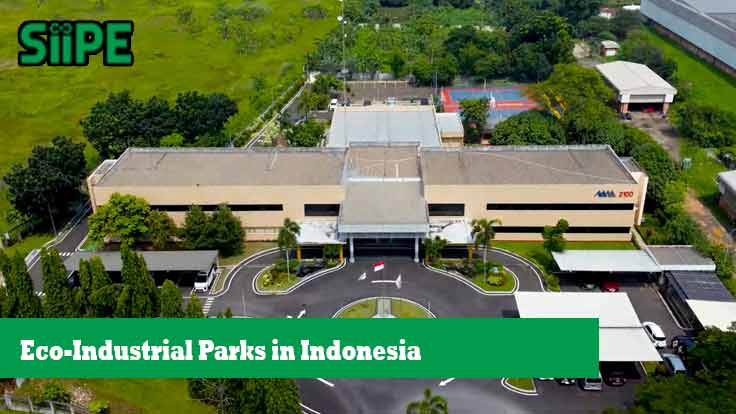Indonesia, as one of the largest emerging economies in Southeast Asia, is continuously seeking ways to accelerate industrial development while preserving environmental sustainability. One innovative and strategic approach to achieving this balance is through the establishment of Eco-Industrial Parks (EIPs).
An Eco-Industrial Park is not just a cluster of factories. It’s a collaborative network of industries and businesses that aim to reduce environmental impacts by sharing resources, reusing waste, and applying green technologies. These parks combine economic performance with ecological responsibility.
In this article, we will explore what Eco-Industrial Parks are, why they are important for Indonesia, which ones are already operating, and what challenges and opportunities lie ahead.
What is an Eco-Industrial Park?
An Eco-Industrial Park (EIP) is a community of manufacturing and service businesses located together on a common property. They collaborate to enhance environmental, economic, and social performance. The key features of an EIP include:
-
Resource efficiency: Reducing water, energy, and raw material use.
-
Industrial symbiosis: One industry’s waste becomes another’s resource.
-
Cleaner production: Using processes and technologies that minimize pollution.
-
Green infrastructure: Eco-friendly buildings, renewable energy, and proper waste treatment systems.
-
Community engagement: Ensuring that the industrial park contributes positively to surrounding communities.
Why Eco-Industrial Parks Matter in Indonesia
1. Environmental Pressures
Indonesia faces severe environmental challenges, including deforestation, air and water pollution, and increasing greenhouse gas emissions. Industrial zones are often contributors to these problems. EIPs help mitigate these impacts by reducing pollution and promoting sustainability.
2. Economic Growth with Sustainability
As the government promotes industrial development through programs like Making Indonesia 4.0, integrating green practices ensures long-term viability. EIPs help industries become more efficient, reduce costs, and access international markets that demand sustainable practices.
3. Global Commitments
Indonesia has committed to reducing emissions as part of the Paris Agreement and its Nationally Determined Contributions (NDCs). EIPs support this commitment by promoting low-carbon industrial development.
Key Eco-Industrial Parks in Indonesia
Several industrial parks in Indonesia have begun transitioning toward the eco-industrial model. Here are a few notable examples:
1. Jababeka Industrial Estate – Cikarang, West Java
Jababeka is one of Indonesia’s largest and most advanced industrial areas. It has implemented:
-
A centralized wastewater treatment plant (WWTP),
-
Green space zoning and biodiversity management,
-
Use of renewable energy in certain sectors.
Jababeka is also a pilot site under the Global Eco-Industrial Parks Programme (GEIPP) led by UNIDO and supported by SECO (Swiss Government).
2. Batamindo Industrial Park – Batam, Riau Islands
Batamindo has adopted energy-saving systems and effective waste management. Its proximity to Singapore also pushes it to maintain high environmental standards to stay competitive regionally.
3. Ngoro Industrial Park – Mojokerto, East Java
Ngoro has integrated solid waste recycling facilities and promotes water reuse in industrial processes. It’s considered one of the more environmentally friendly parks in the eastern part of Java.
4. Suryacipta City of Industry – Karawang, West Java
Suryacipta includes:
-
Environmental Management System (EMS),
-
Green certification for buildings,
-
and programs for community involvement, like waste sorting campaigns and tree planting.
Benefits of Eco-Industrial Parks
✔ Environmental Benefits:
-
Reduction in CO2 and other pollutants.
-
Lower water and energy consumption.
-
Preservation of surrounding ecosystems.
✔ Economic Benefits:
-
Lower operational costs via energy and water efficiency.
-
Revenue from waste byproducts (e.g., biogas, compost).
-
Access to green financing and environmentally conscious investors.
✔ Social Benefits:
-
Safer working environments.
-
Improved health and quality of life for surrounding communities.
-
Creation of green jobs and innovation hubs.
Challenges in Developing EIPs in Indonesia
While the concept is promising, there are several challenges in implementing Eco-Industrial Parks:
1. High Initial Investment
Green technologies and infrastructure (such as solar panels or advanced water treatment) require large capital. Many industrial players are hesitant to invest without immediate ROI.
2. Lack of Awareness and Technical Capacity
Many park operators and companies still lack knowledge about environmental standards or technologies for circular economy implementation.
3. Regulatory Gaps
Although there are environmental regulations, enforcement and integration into industrial policies remain inconsistent across regions.
4. Limited Collaboration Among Tenants
True eco-industrial synergy requires collaboration, but in many industrial parks, tenants operate in silos, reducing opportunities for shared waste and energy systems.
Government and International Support
Indonesia’s Ministry of Industry, in collaboration with the Ministry of Environment and Forestry, is promoting green industry initiatives. Key programs include:
-
National Policy on Green Industry (Kebijakan Industri Hijau Nasional).
-
GEIPP Indonesia, where pilot projects are carried out in Jababeka, Batamindo, and others with support from UNIDO and Switzerland.
-
Incentives such as green financing, tax benefits, and technical support for companies adopting sustainable practices.
Future Opportunities
-
Scaling Up Through Technology
With the rise of Industry 4.0, EIPs can leverage smart meters, IoT for energy monitoring, AI-based waste reduction systems, and other tech to improve performance. -
Expanding Beyond Java
Currently, most EIPs are on Java island. Future development in Sulawesi, Kalimantan, and Papua can drive sustainable growth in those underdeveloped regions. -
Public-Private Partnerships (PPPs)
Collaboration between government, developers, private investors, and international donors can help overcome funding and technical limitations.
Eco-Industrial Parks represent a crucial step in Indonesia’s journey toward sustainable development. They demonstrate that industry and the environment do not have to be in conflict — with the right policies, technologies, and collaborations, they can thrive together.
As the world moves toward greener economies, EIPs will not only help Indonesia meet its climate goals but also make its industrial sector more competitive, resilient, and future-ready.
Q&A Section
Q1: What’s the difference between a traditional industrial park and an eco-industrial park?
A: Traditional parks focus mainly on production, often with high resource use and pollution. Eco-industrial parks integrate environmental practices such as resource sharing, waste reuse, and cleaner production technologies.
Q2: Are there incentives for companies in EIPs in Indonesia?
A: Yes. The government offers various incentives such as tax deductions, green financing, and technical assistance to companies adopting eco-friendly practices in industrial areas.
Q3: Can small and medium enterprises (SMEs) participate in EIPs?
A: Absolutely. SMEs can benefit from shared infrastructure, support programs, and lower environmental compliance costs when located within an EIP.
Q4: How can EIPs contribute to Indonesia’s climate goals?
A: By reducing emissions, improving energy efficiency, and encouraging circular economy practices, EIPs directly support Indonesia’s commitments under the Paris Agreement.
Q5: What role do local communities play in Eco-Industrial Parks?
A: Communities benefit through job creation, cleaner environments, and health improvements. In many EIPs, local residents are also engaged in education, waste management programs, and green initiatives.










